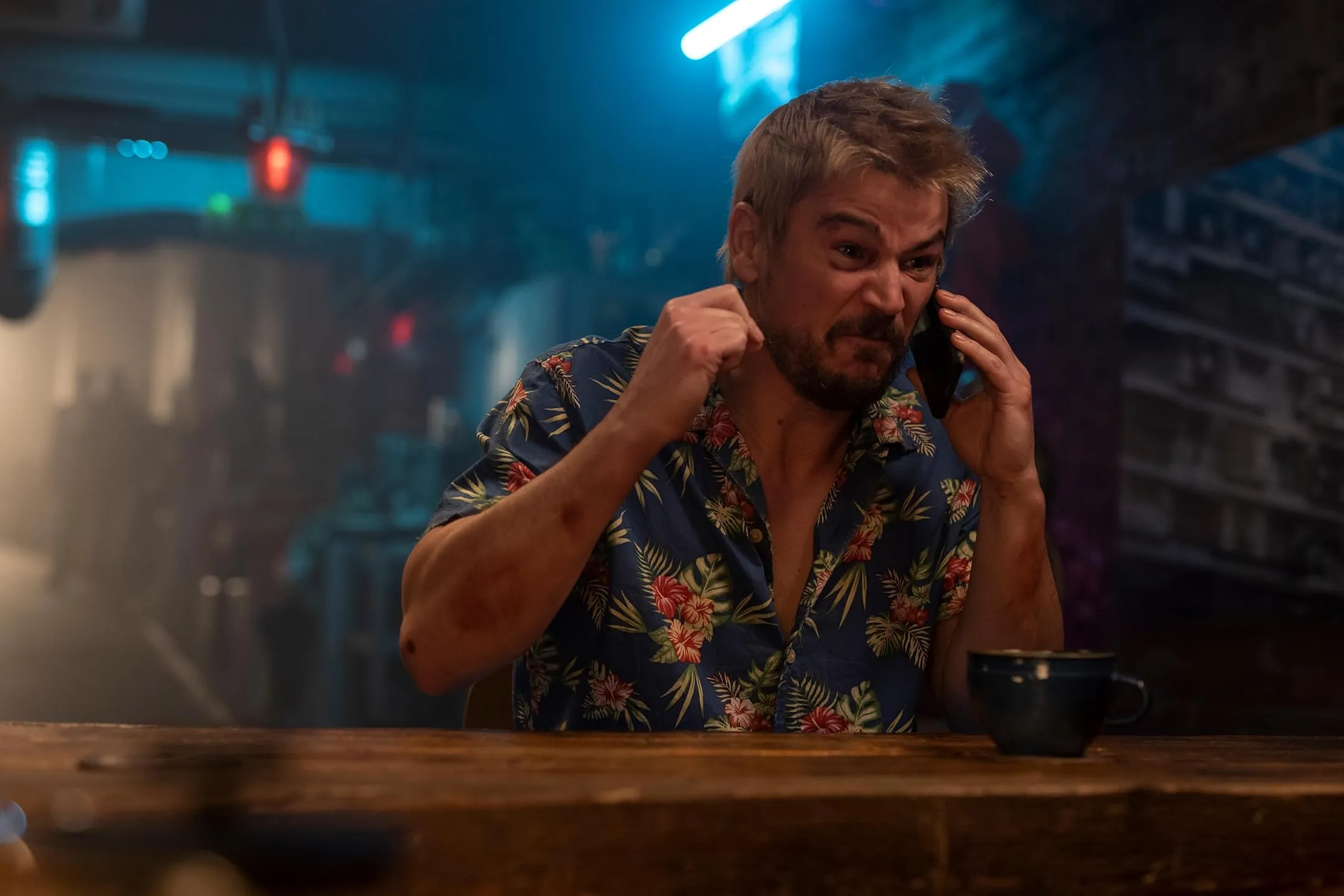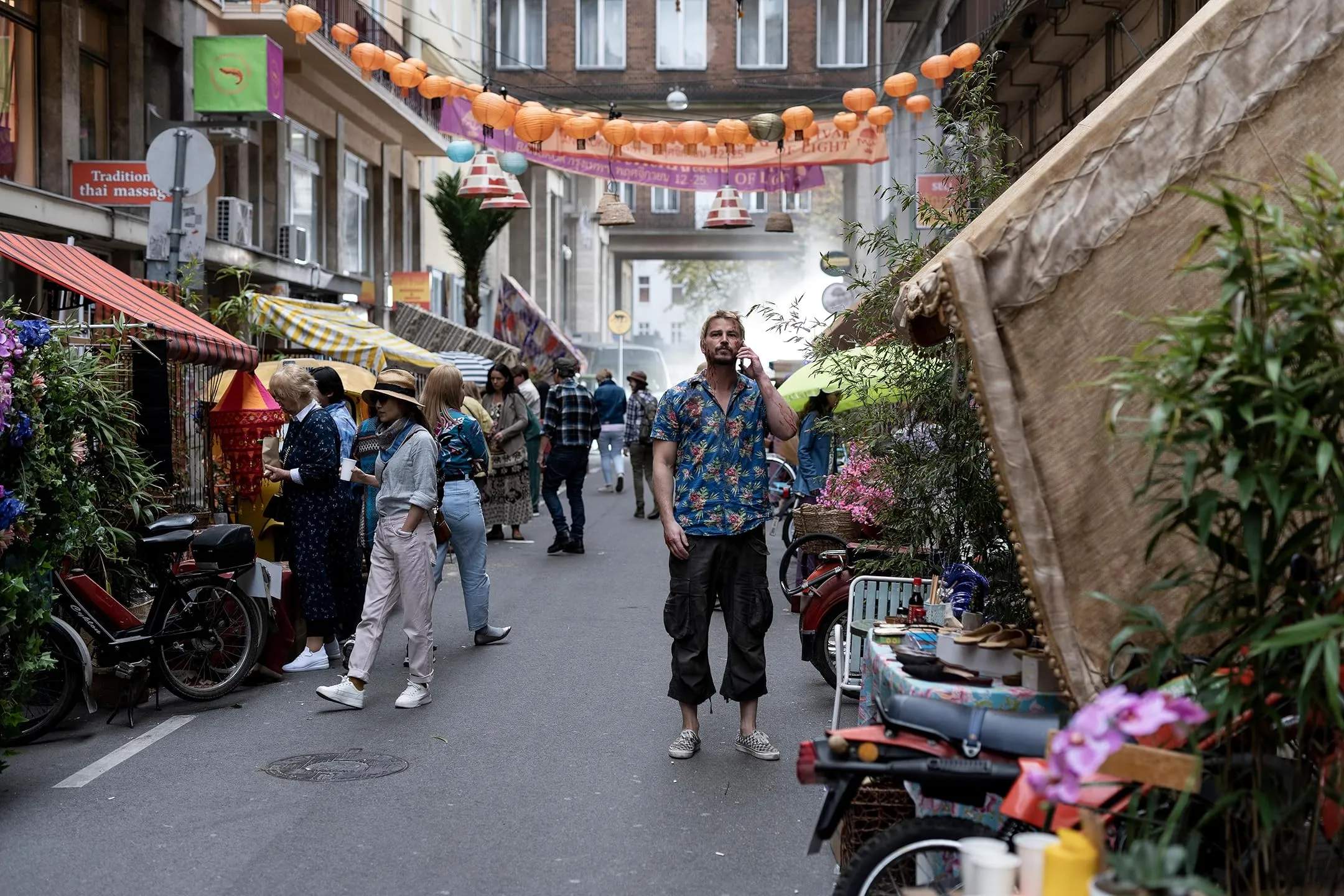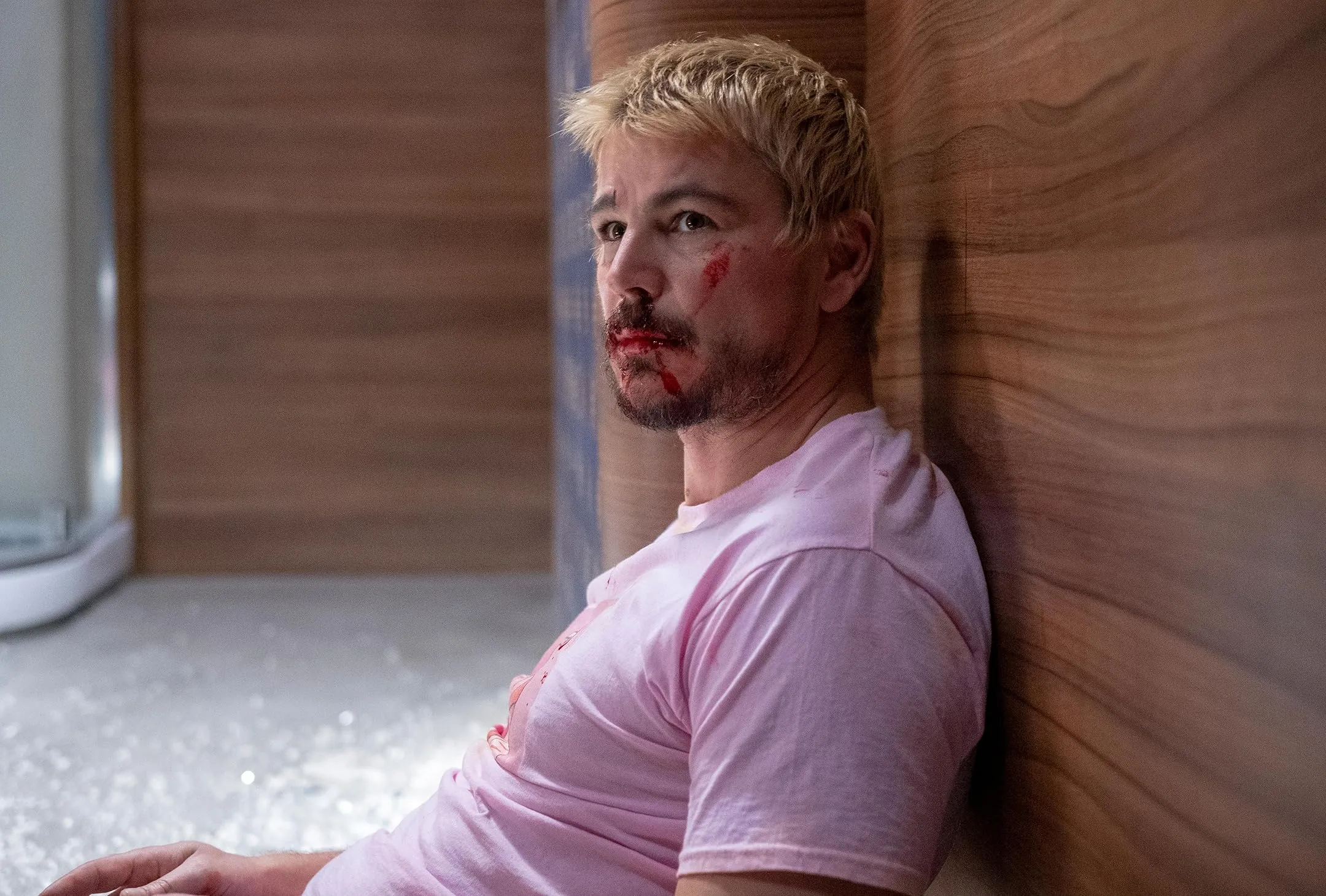Few films dare to transform a passenger jet into a philosophical battleground—Fight or Flight does so with gleeful brutality (one almost expects the beverage cart to launch its own coup). Stranded on Thailand’s no‑fly list, ex‑agent Lucas Reyes is lured into one final gambit: protect a shadowy hacker known only as “The Ghost” aboard a Bangkok→San Francisco flight. What begins as a redemption arc quickly spirals into carnage at 30,000 feet, where every overhead bin becomes a potential arsenal.
James Madigan—making the leap from special‑effects guru and second‑unit director to helming his debut feature—stages each skirmish with the raw intensity of a guerilla photographer (minus the ethical restraint). Brooks McLaren and D.J. Cotrona, in their first produced screenplays, trade in bare‑bones plotting for kinetic set pieces and quip‑laden exchanges.
This high‑octane action comedy channels Looney‑Tunes‑meets‑B‑movie sensibility, yet it carries a curious subtext: flight, once a symbol of escape, here becomes exile incarnate—a kind of aeropiphany (my term) on the cost of freedom. Expect relentless fights, pulp‑thrill velocity, and Josh Hartnett reminding us why his comeback feels predestined.
Flight Path: Anatomy of Chaos
Madigan kicks off with a full‑throttle prologue that feels less like a cold‑open and more like a baptism by fire (or rather, by flying chainsaw). One moment, female ninjas trade shurikens for machine‑gun volleys; the next, a gaping fuselage breach serves as both set‑piece and existential crisis. By rewinding twelve hours, the film straps us into Lucas Reyes’s world—one defined by exile and disillusionment.
Act I lands us in Bangkok’s underbelly: a rain‑soaked bar fight, a hangover‑ridden hero nursing more than just bruises. It’s easy to read Lucas’s sorry state as personal downfall, but perhaps it also mirrors societies fragmented by eroded trust—every punch a metaphor for social dislocation. Then comes the call from Katherine Brunt, a promise of passport and redemption. Boarding the plane, Lucas carries the weight of history’s refugees (only here, the no‑fly list replaces borders).
Act II inflates the pressure cooker. A genial chat with Cayenne lulls us—until Lucas is drugged and forced into impromptu suitcase mortuary duty. His alliance with Isha and Royce (flight attendants turned co‑conspirators) reads like a small‑scale solidarity movement: strangers united under duress. Meanwhile, Katherine and Aaron operate from a subterranean bunker, evoking Cold War‑style command rooms. Skirmishes escalate—seat‑belt lassos, chainsaw jousts, zero‑gravity free‑for‑alls, toad‑venom‑induced hallucinations—each set piece a twisted riff on mankind’s penchant for violence as entertainment.
The climax (Act III) unpacks The Ghost’s identity and Lucas’s true objective, forcing a moral crucible in the aircraft’s cargo hold: hand over the hacker or defy orders to save lives. The subsequent landing and loose threads suggest a sequel seeded in open‑ended fate (call it the “sequel aeropiphany”).
Throughout, Madigan wields flashbacks and foreshadowing like surgeon’s tools—precise, sometimes unsettling. Tension and exposition pirouette together, ensuring that when one lunges, the other doesn’t lag. It’s a kinetic dance between narrative brevity and relentless motion—an airborne chronotrauma that leaves viewers questioning whom—or what—they’re meant to root for.
Passengers of Persona: Performance Under Pressure
From a bar‑dwelling has‑been to near‑mythic protector, Lucas’s trajectory echoes the classical hero‑return myth—think Odysseus stumbling in before reclaiming agency. Hartnett’s physicality (that horse‑tranq brawl could pass for a Cold War submarine skirmish) pairs with a haunted vulnerability in the toad‑venom sequence, where lucid hallucinations morph into violent vertigo. His final moral crossroad—shield The Ghost or obey orders—rings like a modern Geneva Convention dilemma: duty versus conscience. One moment, he’s bonkers fun; the next, genuinely torn. Contradictory, yes, yet strangely believable.
Flight attendants turned guerrilla allies, they shift from polite service workers into pocket‑sized resistance cells. Isha’s quick thinking and Royce’s steel‑nerved calm suggest ordinary citizens rising to extraordinary circumstances—an aeropolitical statement on grassroots solidarity. Their rapport with Lucas humanizes him: she supplies hope, he supplies muscle, and together they craft a makeshift family in mid‑air meltdown.
Operating from a subterranean command room that could’ve been lifted from a Cold War bunker, Katherine embodies Churchill‑like steely resolve; Aaron injects a reckless revolutionary zeal. Their terse tension with Lucas recalls fractured alliances in underground resistance networks—each briefing feels like a chess move with civilian lives at stake.
A cipher wrapped in a gunshot wound, The Ghost stands in for whistle‑blowers and digital dissidents. Anonymous yet pivotal, their presence fuels every coup attempt on the plane, much like Pandora’s box unleashing unforeseen consequences once opened.
From Cayenne’s clarinet‑playing flair to Cat Eyes’s neon contacts, these caricatures evoke silent‑era serial villains. They inject comic relief and genre homage, but also mirror our media‑saturated culture’s appetite for bizarre spectacle—a hall of mirrors reflecting society’s own thirst for stylized violence.
Carnage in the Cabin: Kinetics and Cinema
Brahim Chab’s choreography turns narrow aisles into visceral arenas—each punch feels like industrial machinery grinding bone (I’ll call it “aeroviolence”). Limbs snap with rubbery resistance, evoking trench‑war visuals as if the fuselage itself were a muddy no‑man’s land. The bathroom brawl after Lucas’s drugging plays out like a distorted mirror of personal disintegration: walls pressing in, reflections warped by adrenaline.
A chainsaw tearing through the aisle is more than shock value; it channels the mechanized horror of early 20th‑century battlefields, where man and machine first clashed en masse. Then comes the zero‑gravity skirmish—a brief reprieve that’s also a psychic freefall, symbolizing modern anxieties unmoored from earthly anchors. (Gravity, here, is optional; consequences are not.)
Matt Flannery’s handheld zeal sacrifices stability for immersive chaos. His camera weaves through overhead bins and carcass‑strewn carpets with the jitter of a subway car at rush hour. Rapid cuts punctuate key strikes, yet he pauses long enough for each crimson spurt to register—an uneasy clarity amid pandemonium.
The plane’s two‑story layout becomes a suite of stages: first‑class calm, middle‑cabin bedlam, cargo‑hold crucible. Bright airline hues clash with spattered gore, as if vacation postcards were vandalized by anarchist graffiti. Lighting shifts abruptly, shadows growing teeth in the cargo hold—turning utilitarian space into gothic battleground.
Practical gore dominates (wet, visceral, tactile), with CGI augmentations for toad‑venom hallucinations that blur reality into kaleidoscopic dread. Reaction shots tilt into absurdity—eyeballs popping, blood geysers arcing like modernist sculpture. These moments, while cartoonish, underline violence as spectacle and challenge audience complicity in our digital age’s voyeuristic appetite.
Visually, the film nods to Bullet Train and John Wick—there’s a kinship in frenetic style—but Madigan’s vision crashes through familiar templates with a gleeful disregard for safety protocols (both cinematic and aeronautical). Mood swings from claustrophobic dread to over‑the‑top carnage, suggesting that in this airborne microcosm, reason itself is in freefall.
Scripted Turbulence: Tone and Tongue-in-Cheek
McLaren and Cotrona’s screenplay is surgical in its brevity—no labyrinthine subplots, just a premise hot enough to ignite every aisle. It trades density for momentum, a kind of “goregraphy” manifesto where setup is lean and impact is immediate.
Dialogue snaps like a well‑cocked spring: “You’re stitching a parachute as we fall,” Lucas snarls, and the line lands so hard it echoes historical irony—construction of hope under existential collapse. (Occasionally, tech critiques about child trafficking and slave‑labor supply chains feel more sermon than subtext, but they nod to digital capitalism’s dark underbelly.)
Cartoonish mayhem rubs up against fleeting sincerity. One moment you’re guffawing at a clarinet‑wielding assassin; the next, Isha’s quiet plea recalls wartime resilience—ordinary people finding purpose amid ruin. Slapstick violence coexists with raw emotion, though at times the sentiment flickers like a faulty cockpit indicator. Humor springs from sight gags (chainsaw impalement as applause line), meta one‑liners (“pusswah”) and juxtaposition of high stakes with absurdity.
There’s an almost anarchic self‑awareness here—Madigan winks at genre conventions even as he smashes them to pieces. Rapid‑fire pacing sustains adrenaline, yet some plot twists fold out like creased maps: serviceable, but unsurprising. In this aerial microcosm, tone itself becomes a wingman—unpredictable, occasionally contradictory, and undeniably alive.
Echoes at Altitude: Sonic Architecture
Paul Saunderson’s score thrums with pulsing guitar riffs that nod to protest‑anthem tropes (think Vietnam‑era discontent repackaged for in‑flight turbulence). It underpins high‑octane melees with rock‑infused urgency, then recedes into ominous drones during quieter moments—an uneasy lull before the next figurative crash.
The soundtrack leans on The Let Go’s punk energy, Elvis Costello’s ironic croon, The Clash’s working‑class fury and Goran Bregović’s brass orchestra—each track a cultural artifact colliding like passengers in a terminal. A diegetic clarinet rendition of “The Girl from Ipanema” doubles as comic relief and a reminder that beauty persists amid carnage.
Weaponry impacts crack with exaggerated squelches and bone‑crunches (choreographed gore meets cartoon‑logic). Intercom announcements and engine hums anchor the chaos in reality—a sonic tether to geography even as the plot soars.
Together, music and effects choreograph pacing: riffs drive montages, punctuated by SFX punchlines. At times cohesive; at others, cacophonous—but always evocative of our era’s paradox: we crave both orchestration and entropy.
Underneath the Turbulence: Themes & Subtext
At its core, Fight or Flight stages a redemption crucible. Lucas Reyes’s arc—from disgraced ex‑agent to reluctant guardian—mirrors the odyssey of postwar veterans seeking absolution (returning home only to find the battlefield within). Protecting The Ghost isn’t just a mission; it’s Lucas’s ticket out of no‑fly purgatory, and a bid to reclaim his own life.
The Hacker Plotline injects a modern twist on corporate exploitation. A lone whistle‑blower’s identity (revealed only through a gunshot scar) embodies the risks faced by digital dissidents in an age of mass surveillance. These subtextual cracks expose how data wars and child‑labor supply chains intertwine—serious weight sometimes at odds with the film’s gleeful gore.
Blood‑soaked mayhem here operates as both adrenaline fuel and cultural mirror: we flock to witness choreographed carnage, yet find ourselves numbed by its repetition. It’s thrilling and desensitizing—an uneasy proof of our infotainment era’s appetite for horror‑tinged escapism.
There’s a tacit contract: viewers come for “shut‑your‑brain‑off” thrills. And the film delivers—often brilliantly so. Yet beneath the beastly humor lies a question: when spectacle eclipses substance, do we trade meaning for momentary rush? In these layered turbulences, Madigan’s film invites us to ponder why we cheer chaos even as we reel from its consequences.
Full Credits
Director: James Madigan
Writers: Brooks McLaren, D.J. Cotrona
Producers: Tai Duncan, Basil Iwanyk, Erica Lee, Christopher Milburn
Cast: Josh Hartnett, Charithra Chandran, Katee Sackhoff, Marko Zaror, Julian Kostov, Rebecka Johnston, JuJu Chan Szeto, Sanjeev Kohli, Sarah Lam, Jyuddah Jaymes, Danny Ashok, Attila Árpa, Nóra Trokán
Director of Photography: Matt Flannery
Editor: Ben Mills
Composer: Paul Saunderson
The Review
Fight or Flight
Fight or Flight delivers a raucous, blood‑soaked thrill ride anchored by Josh Hartnett’s kinetic presence and James Madigan’s confident directorial debut. Its lean plot and gleeful gore offer unquestionable entertainment, even as thin emotional beats and occasional tonal dissonance keep it from truly taking flight. Fans of closed‑space action and B‑movie bravado will find plenty to love; those seeking deeper narrative substance may feel grounded.
PROS
- Josh Hartnett’s magnetic physicality and dry wit
- Gritty, inventive choreography in confined spaces
- Relentless pacing that sustains adrenaline
- Clever visual touches (zero‑G brawls, practical gore)
- Sharp dialogue quips that land when least expected
CONS
- Thin emotional underpinnings for central characters
- Plot twists that sometimes feel predictable
- Occasional tonal whiplash between drama and absurdity
- Thematic asides (tech/trafficking) can come off heavy‑handed





















































